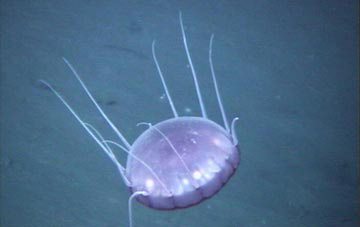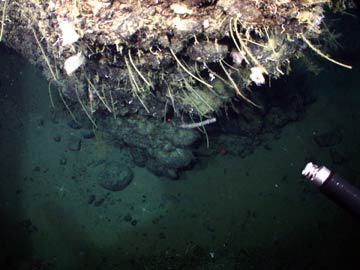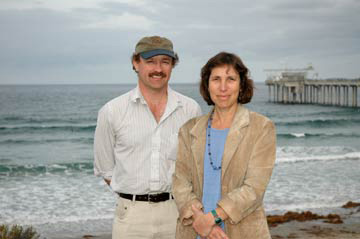 November 24, 2004
Probing the depths below one of the world's most important fisheries, scientists with Scripps Institution of Oceanography at the University of California, San Diego, as well as Indiana State University and their colleagues, conducted the first exploration of deep seafloor biological communities in a sector of the Alaskan margin off the Aleutian Islands along the northern part of the Pacific Rim.
In addition to identifying previously undiscovered deep-sea habitats, the researchers have stirred debate about the causes and characteristics of a devastating 1946 tsunami. The Pacific Ocean-wide event led to more than 150 deaths and widespread destruction as it pounded shorelines from Alaska to Antarctica. The July research cruise, aboard the Scripps research vessel Roger Revelle, was sponsored by the National Oceanic and Atmospheric Administration's West Coast National Undersea Research Program. To achieve a complete picture of how the 1946 event impacted seafloor habitats, the researchers extensively mapped the area, collected sediment samples and probed the region with Woods Hole Oceanographic Institution's Jason II remotely operated vehicle (ROV). They charted new canyons and features of this previously unexplored, remote region of the world. Using multibeam mapping technology, the scientists produced previously unavailable details of the area, a snapshot that gave them new insight into the region's history. In one scenario, scientists had predicted that an enormous undersea landslide in the area unleashed the giant tsunami. The new images, however, counter this explanation by showing no evidence of such a large landslide. "We found seafloor evidence that will cause tsunami modelers to rethink the cause and characteristics of the 1946 tsunami," said Tony Rathburn, a research associate scientist at Scripps and a faculty member at Indiana State University. "Our findings make the causes of the 1946 tsunami even more mysterious." An earthquake may now emerge as the leading cause of the 1946 event, but the scientists say much more investigation is needed to pinpoint the cause due to the new findings. The ROV and sonar explorations revealed a complex set of environments on the Alaskan margin, including deep canyons, steep scarps (walls), sandy slopes and an unusual seamount. While exploring the area, the scientists also discovered previously unknown cold methane seeps and biological communities that exist in such environments. The seeps, found 3,300 meters below the water's surface, were unlike others that have been studied on the Pacific margin. Though the researchers focused on worms, crustaceans and single-celled creatures, they also found clams and other animals that obtain their nutrition from the chemical discharges of the seeps, a process known as chemosynthesis. These creatures contain bacteria that provide nutrition for the "host" animal, while the host provides a home and chemicals from the seep for the bacteria. "At several thousand meters deep, we would notice sparse evidence of animal life, but then all of a sudden we would find, right next to a seep, rocks just completely covered with organisms," said Lisa Levin, a professor at Scripps. "There was 100 percent cover of animal life on these rocks. On one of them that I call 'weeping rock,' the organisms were growing down instead of up, possibly to reach down to the chemical source." The scientists also identified many new, previously unidentified deep-sea coral habitats, some possibly associated with the methane seeps. The expedition included an interdisciplinary team of Scripps researchers, including geologists, geochemists, biogeochemists, biologists and paleoceanographers.
On the Web: Scripps Institution of Oceanography
Source of News:
|
||


